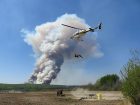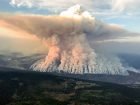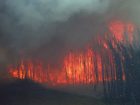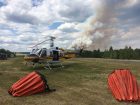
Features
Business Operations
Commercial
Feeling the heat of B.C.’s fires
January 2, 2018 By Paul Dixon
It was a record year for wildfires in British Columbia in 2017 and many operators, which was good news for helicopter operators in the province engaged in aerial firefighting.
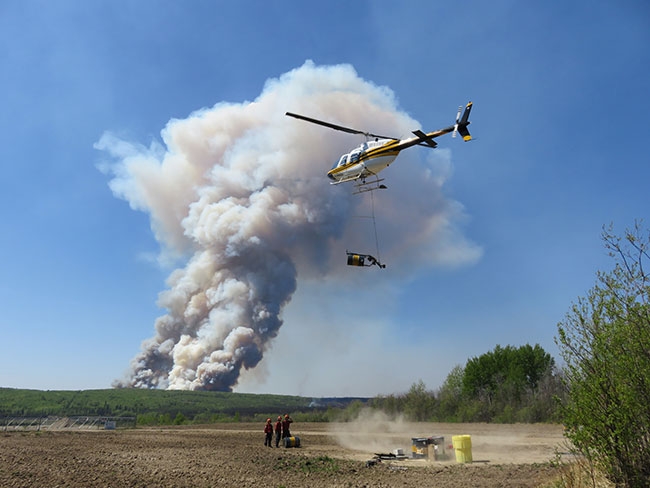 A Yellowhead Bell 208 lifts off with a drip-torch. It was a record year for wildfires in British Columbia in 2017 and many operators
A Yellowhead Bell 208 lifts off with a drip-torch. It was a record year for wildfires in British Columbia in 2017 and many operatorsBy mid-August, 2017 was being described as the worst year on record and the season was a long way from being over. More than 1.2 million hectares burned, surpassing the previous record of 855,000 hectares in 1958, by almost 50 per cent.
There have been other notable fire seasons in B.C in recent memory, as well. In 2003, for example, there were major interface fires in Kelowna and the McLure/Barriere region, from two separate fires that totaled some 26,000 hectares each. The Okanagan Mountain Park fire destroyed 238 homes and forced the evacuation of more than 33,000 residents. In 2009, the more than 3,000 wildfires in B.C. (consuming 66,000 hectares) cost the province some $297 million.
Direct costs from the B.C. fires in 2017 exceed $500 million (and counting). Three fires in particular set this year apart with their sheer size and destructive force. The Plateau Fire saw 19 separate fires converge into one giant fire that was estimated in excess of 521,000 hectares. The Hanceville-Riske Creek fire was estimated at 240,000 hectares and the Elephant Hill Fire at more than 192,000 hectares.
With each of these fires, a combination of pre-existing conditions on the ground coupled with high temperatures and strong winds produced a recipe for the perfect firestorm. Many local governments (municipalities and regional districts) declared states of emergency and, in an unprecedented move, the provincial government declared a state of emergency that lasted from the first week of July through the middle of September. Evacuation centres were opened in communities across the province to accommodate the more than 55,000 people forced from their homes by evacuation orders.
A declaration of a state of emergency by a local authority (municipality or regional district) gives certain powers to that entity as well as allowing it to receive financial support from the provincial government. When the province declares a state of emergency, this in turn allows the province to receive financial assistance from the federal government, as well as assistance from the Canadian military and other federal agencies.
With the exception of the military, which is generally highly visible, most federal assistance is at the senior management and policy level and not readily discernible. The Canadian Armed Forces describes its role as providing highly-trained personnel and unique resources tailored to the situation at hand. For the aviation role in this year’s fire assault, the Royal Canadian Air Force (RCAF) deployed one C-17 Globemaster, a C-130J Hercules, two CH-147 Chinooks and three CH-146 Griffons to B.C. The aviation assets did not replace civilian assets, but augmented emergency operations.
Staying On the Hot Seat
So, how busy was 2017 for the rotary-wing community? Leanne Ingham, B.C. Wildfire’s superintendent of aviation management, notes more than 39,000 hours were flown by rotary operators and another 10,000 hours were spent on standby. On August 9, the peak of helicopter activity, some 200 helicopters were fighting fires throughout the province.
Ingham characterized 2017 as a “challenging year” but challenging in different ways depending which side of the coin you live on – wildfire agency or helicopter operator. Challenging translated as busy for many operators this year, but there was the question of the impact the fires had on other sectors of the economy that helicopter operators would normally rely on for their summer business – tourism, forestry, oil and gas, and mineral exploration to name a few – either because of the actual threat of fire, widespread forest closures or the number of helicopters working on the fires.
For Brad Fandrich at Valley Helicopters out of Hope and Merritt, B.C., the extensive fire season turned out to have little impact on their operation in terms customer inconvenience, but it did provide a nice jolt in the operational bottom line.
“For the most part, it caused just a slight impact on their other customers, as most of them put off what they needed until later in the year,” Fandrich says. “We’re back to doing some things that we would have done in the summer, but they got put off by the fires – by the smoke in most cases. We typically never give all our fleet to firefighting; instead we hold back one or two helicopters to take care of our long-time customers.”
Over at Blackcomb Helicopters, Andrew Bradley told Helicopters, 2017 turned out to be their second busiest fire season in his 15 years with the company. “Most of our clients still work in the bush, but when they’re not allowed to access the bush, we dispatch our helicopters to the fire regions. It works out well for us.”
Vancouver’s Talon Helicopters also had a busy season, as founder/operations manager Peter Murray explained. “We’re a base operation. We’re happy to do some firefighting and we do it if we’re needed, but we maintain the base for search-and-rescue and our other local customers. Summer’s always a busy season and we balance the workload around with what we had available.” One of those other jobs for Talon was flying a British documentary crew and filming fire activity.
A Changing Landscape
Peter Barratt at West Coast Helicopters can look back over 42 years in the commercial helicopter business and while he’s definitely seen a change in the B.C. firefighting business over time, there has also been a shift in the whole business universe.
“We used to count on a really good fire season about once every seven years, but we’ve seen that change drastically,” Barratt says. “Whether it’s one every two years or three years, I don’t know, but there’s no doubt it’s changed. To cope with that, our business model has diversified. We used to be about 90 per cent forestry, but now it’s about one-third forestry, one-third tourism and one-third miscellaneous and the variety of things we do in that miscellaneous third is huge. I do think diversification is the key to survival in this business.”
Another prominent B.C. operator who wished to remain anonymous told Helicopters that his company has noticed a definite shift in the aerial firefighting business in B.C. As he explained, there are far more challenges now for some operators trying to keep up in acquiring shifts.
“It used to be, 30 years ago, that a company could put a Jet Ranger into a small community for the summer and bank on a certain level of business through the fire season,” he said. “But that’s not the case now. When you add in the other hours from a diverse mix of local businesses, back country operators and with firefighting as the foundation, a lot of those 10- and 20-hour segments would make the base work and an operator could get between 300 or 400 hours out of the operation. Today, the Jet Ranger is no longer the helicopter of choice and, given the costs of operating new intermediates, the business case just doesn’t make sense.”
Providing the right support
For the first couple of months of the 2017 fire season, personnel from B.C. Wildfire were heavily involved in flood support work. But on the heels of widespread flooding in B.C.’s interior, temperatures spiked, the winds grew and a rash of dry thunderstorms in the first week of July literally ignited a firestorm.
The Plateau, Hanceville-Riske Creek and Elephant Hills fires started in a window in early July, primarily the 6, 7 and 8. Like all fires they started small, but given that combination of dry fuel, hot dry weather and strong winds they were doubling in size in hours and just simply kept growing and growing. It’s not unusual to see fires grow this quickly, but usually there is a break in the weather or at least a reprieve that gives firefighters a chance to get ahead of the fire. This year, that break didn’t come. The weather was hot, humidity was low and winds were high.
Fortunately, B.C. Wildfire has plenty of resources at its disposal to deal with the challenges. As Ingham notes, the province has a list of more than 140 helicopter operators on file, representing a potential pool of more than a 1,000 helicopters.
“We need all the support we can,” she says, “with the realization that this is made up from operators from across the country. Hopefully we never have a year where multiple provinces are having a bad season at the same time, because that could lead to some problems with aircraft.”
With the sudden onset of fires that first week in July, Ingham and her staff had to be prepared for the next big thing. “We kept aircraft on standby, waiting for the next big lightning bust to through and we never really got one,” she said. “That’s unusual for two months of extreme fires. We try to be as ready as we can (for what might happen next), but we were already busy enough. We were doing well for aircraft, but we were thinking that if we got an interface fire in Kelowna or Penticton or Lillooet it would draw a lot of resources. We had to be aware of that possibility, which we thought would be inevitable, but it didn’t happen.”
Another challenge Ingham encountered this year came from the need to release helicopters to help out in the forest industry. “We have great support from the forest industry but as the season dragged on it really was having an impact on their ability to get timber supply into the mills. With some negotiation, we released some heavy helicopters we work with under contract to keep the mills open. It’s not something you would have to consider in an average year.”
Challenges in the Air
It’s always important to have a diverse selection of aerial firefighting assets at your disposal when faced with the complexities presented during the 2017 fire season. But as Ingham notes, the availability of fixed-wing assets from other provinces – CL-215s and CL-415s – also created unique challenges as some helicopters and scoopers had to be kept apart.
“It was quite hard to plan for that,” Ingham said, “because the fixed-wing aircraft are not assigned to a specific fire as most helicopters are. They are a provincial asset and get assigned every day, depending on the need and prioritization. There were times this year where we would have 20 helicopters on a fire and the CL-415s would show up and that would limit the need for buckets on the fire. We would end up with unflown hours that day, but the next day, the CL-415s weren’t available so the helicopters would go back to work.”
Continued Safety Commitment
Given the complexities presented by the 2017 B.C. fire season, Ingham notes that she is pleased with the final safety performance of all operators involved.
“We only had one accident all year [an EC-130 crashed on July 15 in the Alexis Creek area], which is remarkable considering some of the difficult conditions they were flying in. We work with a great team of pilots and companies. We’re really proud of our safety record.”
Which leads into the discussion at this year’s Helicopter Association of Canada Conference this November in Ottawa with Transport Canada (TC) governor generals Denis Guindon and Aaron McCrorie regarding new flight and duty time regulations, which could severely limit firefighting operations for operators and provincial firefighting agencies.
“I support anything that addresses aviation safety,” Ingham said. “More specifically, we are trying to keep a high standard of pilot and if the available amount of pilots is reduced by them needing more time off for fatigue regulations, then it’s a concern for us.”
The new TC regulations will impact the availability of resources when the agency is busiest, Ingham said. “And that’s a real concern for us. If we don’t have enough aircraft to do the job, then that’s a concern.” What complicates this is the reality that many operations in firefighting are conducted as both 702 and 703 on the same mission.
HAC and the eight other Canadian aviation associations continue to fight the new regulations in the run-up to the consultation deadline between their publication in Canada Gazette I and Canada Gazette. “We continue to support HAC’s position on what the impact of this is on the industry,” Ingham said. “This year we had enough aircraft to do what we needed to do, but a few times this year we had companies that had to turn down contracts because they couldn’t stop an aircraft. Will the fatigue regulations increase safety the way Transport Canada is saying they will?
